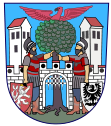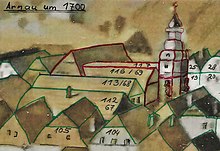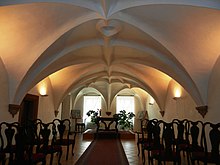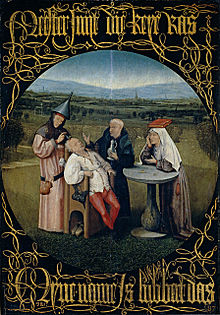List of Mayors of Hostinné
This list of mayors of the city of Hostinné , Arnau in German , partly taken from the historical city book shows the mayors and mayors from 1396 to 1945. The elected mayors were mainly elected for one to two years by the town council. There were up to ten lay judges on the council. A judge was part of the city council. Although several noble families lived in the village, only the township provided the mayors.
town hall
A town hall in Arnau was first mentioned in 1477. A new Gothic town hall was built in 1525 , so there was a previous building. In 1566 the powder tower connected to the town hall exploded , after which the town hall was rebuilt in the Renaissance style by the Italian architect C. Valmadis between 1570 and 1600. The city lords of the time, those of Waldstein / von Wallenstein , sponsored the building. In 1610 the town hall burned again in the great city fire. Historically, the town hall consists of two individual houses, which became one by merging common rooms. In 1875 two gables facing the ring could still be seen. In 1899 the shape of the roof changed to a dormer roof. Today the original form is no longer recognizable. A door bar inside shows the year 1591, a year later the von Waldsteins bought the southern town house with its wine cellars and brewing business from the Gernert family . This adjoining house was mostly used as a hotel or inn.
- There is a large shed on the ground floor, it was built for the council wagons.
- Council rooms on the upper floor - since 1938 the filigree hall of the town hall also served as a wedding room (photo).
- Gothic cellar vaults - In the town hall cellar, there is evidence that since 1579 the serving of white and red wine to the councilors has been documented with 262 buckets in a wine bill from the councilors and wine tavern Matthes Gernert and Jakob Heier. An imperial tax for serving wine was also shown. The bohemian bar bucket measured 61.43 liters. Around 16,000 liters were consumed in one year. The connected Ratskellergewölbe were big enough to store at least 80 wine barrels of 200 liters. The Gothic-built cellar vaults on the town hall side of the market were formerly connected to one another for defense purposes. The brickwork of former connections shows that Arnau was built strategically. An underground battlement from the town hall under the city wall to the Töpferberg was filled in in the 19th century. In the vedute of 1700, an even higher, no longer existing house with an unknown use was built on the back of the town hall (probably a granary). The city structure of the 15th century allowed a later expansion to the east. The arcades for the new market design (ring) were only added in the 16th century, for this reason the arcades do not have a cellar. The tower at the town hall was free until the arcade was added.
mayor
The following people were Schultheiße, Mayor of Arnau, Czech Hostinné:
- 1396 - Merten the hereditary bailiff of Arnau
- 1477 - Master Johannes
- 1478 - Jakob Lorencz and Mikisch Czikan
- 1479 - 1482 Nikols and Heyntze
- 1484 - Anderle Zechmeister and Peter Meister Zechmeister
- 1483 - 1485 Heinze and Johann Pabelig
- 1486 - Georg Jaros
- 1487 - 1489 Georg Schreiber, Johannes Pruss and Paul Fleischer
- 1490 - Paul Pfaffe and Thomas Fleischer
- 1491 - Georg Pruss
- 1492 - Pfaffe and Martin Lomüller
- 1493 - Pruss and Nickel Schtrogel
- 1494 - Jenke Pabelig and Merten Zimmermann
- 1495 - Jenke and Paul Pfaffe
- 1496 - Thoma and Merten Schibel
- 1497 - 1499 Pruss and Jakobi
- 1500 - Jakobi and Wolfgang
- 1501 - Martin Schiebel and E. Brener
- 1502 - Jakobi and Wolfgang
- 1503 - Prusse and Strögel
- 1504 - Georg Schreiber and Martin Schiebel
- 1505 - Jakob Heinz and Wolfgang Schlosser
- 1506 - Georg Schreiber and Prusse
- 1507 - S Strogel and Jakob Fleischer
- 1508 - Martin Schiebel and Paul Groff
- 1509 - Thomas and Wolfgang Schlosser
- 1510 - Georg Fiedler and Vincenc Fleischer
- 1511 - 1512 Jakob Heinz and Bartolomae Styr
- 1513 - S Lomüller and Bartolomae Styr
- 1514 - 1515 Jakob Heinz and Martin Lomüller
- 1516 - Martin Schiebel and Mathäus
- 1517 - S Lomüller and Wenzel Czikan
- 1518 - 1519 Mathias Briccius and S Bartel
- 1520 - S Lomüller and Wenzel Czikan
- 1521 - Martin Lomöller
- 1522 - Jakob Heinz
- 1523 - 1524 Mates Neidek
- 1525 - 1526 Bartel Styr
- 1527 - Wenceslaus Czikan
- 1528 - Mates Neidek
- 1529 - Mates Stüler
- 1530 - Wenceslaus Czikan
- 1531 - Andreas Hartmann and Schneider Anderle
- 1532 - Wenzel Stibel / Schiebel
- 1533 - Lorenz Kannegießer and Mates Neidek
- 1534 - 1535 Schneider Anderle
- 1537 - 1539 Wenceslaus Czikan
- 1540 - Wenzel Schiebel
- 1541 - Wenceslaus Czikan
- 1542 - 1543 Mates' pupil
- 1544 - 1545 Schneider Anderle
- 1546 - 1547 Mates Neidek
- 1548 - 1549 Hans Pol
- 1550 - 1551 nobility Heuer
- 1552 - 1553 Jorge Hrudisch
- 1554 - 1555 Adam Heuer (or Hoer)
- 1556 - Hans Pol
- 1557 - Hans Pol and Adam Heyer
- 1558 - Jörge Hrudisch and Bonifaz Czikan
- 1561 - 1563 Adam Hoer
- 1564-1565 (-1566) Bonifaz Circan
- 1567 - Hans Pol
- 1569 - 1570 Christof Dreischuh
- 1572 - 1574 Hans Holey
- 1575 - 1580 Georg Holey
- 1581 - 1592 Hans Hanke
- 1593 - 1599 Adam Landek
- 1600 - Adam Hanke the Elder
- 1601 - Jakob Dreischuh
- 1602 - Kaspar Khun
- 1603 - Adam Lomüller
- 1604 - Michael Steidinger
- 1605 - Peter Klyp
- 1606 - Georg Haler
- 1607 - Mathias Nitsch
- 1608 - Mathias Hampel
- 1609 - Donath Schrösser / Schlösser
- 1610 - Adam Hanke the Elder
- 1611 - Johannes Gernert
- 1612 - Mathias Hampel
- 1613 - Mathias Nitsch and Balthasar Dreischuh
- 1614 - Mathias Hampel
- 1615 - Adam Heuer
- 1616 - Paul Steidig
- 1617 - Balthasar Dreischuh
- 1618 - Mathias Hampel
- 1619 - Adam Dreischuh.
- First juror Mattheß Hampel, jurors Balzer Dreischuh, Mattheß Stiller, Hanß (Johannes) Gernert, Paul Hanicka, Procop Proschwitzer, Georg Scholtz, George Haan, Christoff Stransky, Merten Khun, city judge Mattheß Fieker
- 1620 - 1622 Mathias Hampel
- 1623 - 1624 Adam Dreischuh
- 1625 - 1626 Mathias Stiller
- 1627 - 1630 Balthasar three-shoe.
- In 1629 the city council forcibly converted back to Catholicism.
- 1631 - 1632 Mathias Stiller
- 1633 - 1634 Balthasar three-shoe
- In 1639 Laurentius Dreischuh, 87 years old, was beaten by Sweden and died from it. It is obvious that Dreischuh`s was tortured by the Protestant Swedes. During her term of office, the city council had to become Catholic again.
- 1635 - Stefan Deyl
- 1636 - Martin Neumarkt
- 1637 - 1639 Kristoff Hoffmann
- Departure of exiles to Horní Branná . Hundreds of people are said to have gone into misery because of the Catholic Reformation.
- 1640 - Johannes Hänke
- 1641 - Georg Stiller
- 1642 - Wenzel three-shoe
- 1643 - Augustin Osip
- 1644 - 1645 Augustin Osip the Younger
- 1646 - 1648 Georg Stiller
- 1649 - Augustin Osip the Younger
- 1650 - 1651 Johannes Hänke
- 1652 - Georg Haan
- 1653 - 1655 Sebastian Klipper
- 1656 - 1661 Georg Hoffmann
- 1662 - 1683 Sebastian Klipper
- 1684 - Georg Haan
- 1684 - 1690 Sebastian Klipper
- 1690 - 1693 Andreas Schild
- 1694 - 1697 Johannes Pastor Dreischuh
- 1698 - 1701 Martin Hannemann
- 1702 - 1703 Johannes Pastor Dreischuh
- 1704 - 1709 Franz Anton Matzak
- 1710-1735? Unknown
- 1736 - 1741 Jakob Thym
- 1742 - 1745 Jakob Thym the Elder
- 1745 - 1750 Johannes Georg Havel
- 1750 - 1766 Franz Raihm
- 1767 - August Thym
- 1768 -? Unknown
- 1779 - 1771 Anton Boehm
- 1772 - Alois Hittner and Antonin Böhm
- 1773 -? Unknown
- 1774 - Antonin Paumler
- 1775 - 1777 Augustin Thym
- 1778 - 1783 Anton Böhm and August Weiss
- 1784 - Augustin Thym
- 1785 - 1787 Anton Böhm and August Thym
- 1788 - 1788 Mathias Siegwein
- 1789 - Anton Böhm
- 1790 - 1795 Augustin Thym
- 1795 - 1798 Johannes Lorenz and Anton Böhm
- 1799 - Franz Lorenz and Anton Schreier
- 1800 - Josef Anton Schreier and Franz Lorenz
- 1801 - Augustin Thym and Franz Lorenz
- 1802 - Franz Lorenz and Franz Jesser
- 1803 - Franz Lorenz, Franz Jesser and Franz Lorenz
- 1804 - 1809 Franz Jesser, Franz Anton Gernert (certified judicial councilor), Wenzel Bittner (2nd councilor)
- 1810 - 1814 Johannes Lorenz, Franz Anton Gernert (certified judicial advisor)
- 1814 - 1827 Anton Bittner, Franz Anton Gernert +1818 (certified judiciary)
- 1827 - 1835 Johannes Widtmann
- 1836 - 1846 Franz Lorenz
- 1842 - 1850 Josef Deyl
- 1850 - 1851 Heinrich Steffan
- 1851 - 1861 Anton Wollrab
- 1861 - 1867 Vaclav Pavel Czerweny
- 1864 - 1866 Franz Hanusch
- 1866 - 1867 Vaclav Pavel Czerweny
- 1867 - 1870 Jan Bukowsky
- 1870 - 1872 Johannes Kopp
- 1872 - 1875 Jan Bukowsky
- 1875 - 1878 Heinrich Karl von Bebenburg
- 1878 - 1879 Wenzel Kühnel
- 1879 - 1891 Jan Podhaisky
- 1891 - 1895 Franz Rauch
- 1895 - 1898 Josef Stecker
- 1898 - 1918 Heinrich Schwarz - was deposed by Czech occupiers in 1919.
- 1919 - 1923 Franz Czernohous
- 1923 - 1931 Ignaz Janetschek
- 1931-1938 Emil Reil
- 1938 - 1945 Karl Röhrich
From 1945 onwards, only Czechs were elected as mayors in Arnau / Hostinné through the four-power agreement.
- 2016 - Dagmar Sahánkova
City book Arnau 1600 and 1688
The first handwritten pages of the oldest still preserved Arnau city book are artistically made in italic Renaissance script until 1610 . The initials are based on sculptures from the Renaissance. The missal in the picture "Der Steinschneider", which was ascribed to the painter Hieronymus Bosch until 2016, around 1494, can be seen as an example of the feather-hatched bold script by the town clerk Valten Stübner (1580) von Arnau. The peculiarity is that the scribe Arnaus has tied the initials of the first and last names with pearl-like rings. In 1591 and 1600 there are special decorations on the initial in the title of the book and on the deed of purchase of Mr. Zdenek von Waldstein (Moravian nobility). A previous city book was lost in a city fire. Individual documents that still existed after the fire were cut and bound together to form an anthology. This volume was continued as the city book. That is why there are 1600 entries in the city register that go into the past 16th century. The renaissance script continues to be written in chancellery script in the running text. A lost first city book began as early as 1477, some facts were included in the following city book. A common Gerneth family, including Gernert, had several houses in the city, including a house on the Burgerfirtel near Niderthor in 1528 . The change and simplification of the script is shown in the following table using the example of the Gernert patrician and councilor family , who immigrated from Franconia in the 14th century. The family provided city councils and lawyers from 1506 to the 19th century, and the name is lost in the city at the beginning of the 20th century. In the Bohemian language, the G for the K and Kh was often found , as is the case with Kotvald instead of Gottwald . Görnert also originated from Gernert (Arnau 1682 to 1700). In the surrounding places the name changed in Hohenelbe to Kherner , in Wildschütz to Kernert and in Tschermna to Kerner . In Trautenauer sources near Simon Hüttel in 1573, Gern`t and Gern`dt appear in the abbreviated form of names for a citizen of Arnau. A second city book begins in 1688; around 1700 the font in it became more and more factual and almost no longer decorated.
The ability to execute and master cursive script so perfectly fell on fertile ground in Arnau. In 1525 an author of a pamphlet gave Eyn Wegsprech towards Regenspurg to / unß Concilium / between eynem Byschoff, whore landlord / and Kuntzen his servant , 37 pages 15 × 20 cm, Arnau as the place of printing. The author wrote: Printed at Arnau on the Elbe in Bohemia by Hans Hoß von Brawn. anno MDXXV.
| year | Text, transcript, note | Side illustration |
|---|---|---|
| 1600 |
Newes purchase or inheritance register from Keuffen the city of Ahrnaw ascending from Jharess 1600
|
|
| 1572 |
Hanß Gernert Hatt period of the previous city Buchs Unndt Erb register in 1572 Jhare, his house in the city, like a garden sambt Bedrullien, and the heirloom ..... on it, .... Bought by Hannß Gernert his father umb 280 shock
|
|
| 1591 |
Mr. Zdenek von Waltsstein His Genaden ec. Have your graces, announcement of the preceding city of Buchs: In 1591 Jhar, Dem 11 Marei, Daß Hauß so between the town hall and Wentzel Arnderius, Zußambt all Eckern and Beheuren belonging to it from Mertten Gernertin Bought umb 910 Schock. Thereupon your Genaden, Gemeltem Mertten Gerner leave numbers out of the 390 shock He received and made a proper renunciation. The lord of his comrades then remains to pay. 520 shock
|
|
| 1596 |
Mertten Gernertt had the fortune of the previous city book and inheritance register in 1596, at the house in the city, so between Mertten Schaffs and George Meßners, bought by George Erbnerin around 170 shock
|
|
| 1628 |
Adam Gernert had this 1628 year the 3rd of April with Consens EE Ratths his house was all around between Ursula Hankin Kirchblatterin and Adam Hegerer Heusern, sambt three pieces of land on the Newen worries, and half a heavy weight next to Merten Khunes, with all and every justice bought by his mother and siblings, mod summa 540 shock
|
|
| 1655 |
Friedrich Seydel Kauff in the Niedervorstadt. Anno 1665, at the end of December, he bought his house in front of the Niedertohr near the cupboard next to the Thorheißel on the Wohlgraben with all fairness from his mother in law, Catharina gernertin, for a sum of 100 shock
|
|
| 1667 |
Godtfriedt Gernert, on January 11th, bought his meat bank between Jacob Schwarzers and Christoff Wagner’s meat banks, with all undoubted justice from Ballthasar Hantscher and Elisabetha Framkin in front of heirs for a summa 210 shock
|
|
| 1673 |
Godtfriedt Gernert Has his house on April 14th, 1673, on the Ring between Mertten Frostens and Gemein Hauße, all of them have no fairness: Ann Rayne and gräwen how the old previous owner used and enjoyed himself, item niedt and nagelfest bought by Hannß Schrayber 215 shock
|
|
| 1690 | The surname of Gottfried Gernert is renamed in the city book in a Silesian-Saxon form from Gerner to Görnert | |
| 1688 |
Ahrnauisch Ober- Unndt Nieder Tor townspeople Newes City Buchs der Erb Register von Keuffen and Erbschichten. ANNO MDC.LXXXVIII is set up in this way
|
|
| 1702 |
Wentzel Gernert had his WonHauß on the ring on the other side of the corner next to Tobiaß Hawels in 1702 on July 17th, with all iniquity not nailed firmly used and andt enjoyed by an honorary council in the name of the averse Andreaß Schilk but with the well-being of his wife, who was abandoned here Purchased Umb Summa 215 shock
|
|
| 1810 to 1827 | Franz Anton Gernert, certified judicial councilor of the municipal city, was the last councilor of the Gernert.
Bankruptcy announcement for the reoccupation of the city of Arnauer-checked Magistratsrathsstelle. Due to the death of the certified councilor Franz Anton Gernert, a council office connected with the fixed annual salary of 300 florins and a covolument of 8 kl. Firewood per year has been dealt with at the Arnau magistrate. However, since the citizens of Arnau have voluntarily accepted an annual salary contribution of 200 fl. WW up to the establishment of an equality of the value of the paper and conviction money, and the resulting freedom of choice for food, which with the approval of the high state office according to the ordinance of 23. January 1818, Rb7, 615 would be collected by way of repartizion according to the taxable occasions for the attention of the audited Arnauer Magistratsraths, then this voluntary civil salary contribution without temporary tax allowance pr. 200 fl. Annually to the systemized annually 300 fl. To be administered to the audited council by the municipal accountant. Those who wish to obtain this Magistratsrathsstelle, have their due with the electoral decrees over the examination from the Jubicial u. political subjects, and with the morality certificates, then about their use in their current service category documented until April 6th d. J. to be submitted herewith. Kk District Office Gitschin on February 28, 1819 |
literature
- The old homeland- Arnau an der Elbe- in the Giant Mountains of Dr. Otto Weiss Volume 2, Page 1010-1013 List of Mayors
- City book of Arnau from 1477 to 1520, town clerk Simon Hüttel, Leeder page 45
- List of mayors of the city of Arnau (1477-1945), Czech State Archives Trautenau
- Alfred Meißner u. Dr. Karl Schneider: The land on the high Elbe (Arnau and Hohenelbe), pamphlet of homeland education, issue 17, Sudetendeutscher Verlag Franz Kraus, Reichenberg 1921.
Individual evidence
- ^ Georg Schmidt: Register of the wine trade 1579 (in Arnau) . In: Association for the history of the Germans in Böhmen (Hrsg.): From the communications of the Association for the history of the Germans in Böhmen . No. 47 , p. 94 -100 .
- ↑ Franz Jesser in Schematism for the Kingdom of Bohemia for the year 1809: first part , google.books, accessed November 4, 2017
- ↑ Johannes Lorenz in Imperial and Royal Schematism for the Kingdom of Böheim on the common year 1814 , google.books, accessed November 4, 2017
- ↑ id = 1phjAAAAcAAJ & pg = PA195 & lpg = PA195 & dq = Thym + Arnau & source = bl & ots = 2RsyBq9Q11 & sig = UrX9z0qURyBHySUwzHA8CrA8VoE & hl = en & sa = X & ved = 0ahUKEwj-0PbUjMjWAhXHuxQKHa9jAbcQ6AEIYTAP # v = OnePage & q = Thym% 20Arnau & f = false Anton Bittner in Royal Imperial Schematismus for the Kingdom Böheim on the common year 1819 , google.books, accessed November 4, 2017
- ^ Karl Leeder, Contributions to the history of Arnau, Prague 1872, communications from the Association for the History of Germans in Bohemia, pages 44 to 47
- ^ "Only in the oldest settlement Arnau do the old names Gernert, Richter, and others no longer prevail due to significant immigration and emigration." Page 12 from Sudeten German Heimatgaue. The land on the high Elbe. (Arnau and Hohenelbe), 1921 Issue 17, Verlag Franz Kraus, Reichenberg
- ^ The Sudetendeutsche surname book of the 15th and 16th centuries by Ernst Schwarz, 1973 from Robert Lerche-Verlag writes on p. 104, Gernot, 1415 Peter Gernot MSch-SB109, 1528 Merten Gerneth (Arnau) MGB 11, 58. A witness for the popularity of the Nibelung poem ...... is called the Gernot Brothers.






















